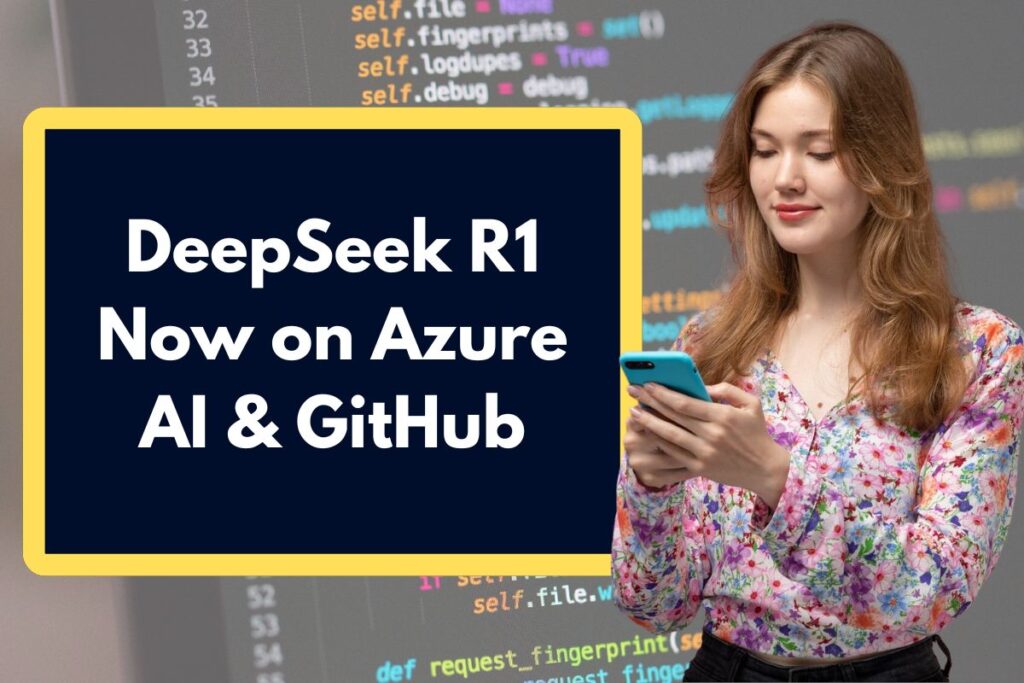The R1 AI model from Chinese startup DeepSeek is now accessible on Microsoft’s Azure cloud computing platform and GitHub, extending the company’s artificial intelligence services. To access DeepSeek R1, developers need to find the model in the Azure AI Foundry catalogue, get the model card, then deploy it to get the key and inference API.
Prior to integrating model into apps, users may test it in a playground setting. Developers may also find further materials and integration instructions for DeepSeek R1 on GitHub. Future iterations of the model will be accessible in simplified formats for local deployment on Copilot+ PCs, according to Microsoft.
DeepSeek R1 Now on Azure AI & GitHub
Microsoft’s Azure AI Foundry and GitHub have made DeepSeek R1, a state-of-the-art open-source AI model known for its sophisticated reasoning skills, available. For jobs involving intricate problem-solving, including coding, mathematics, and analytical thinking, this integration provides developers with a powerful tool.
The company has integrated DeepSeek’s R1 model into GitHub and its Azure AI Foundry platform. The change is probably going to make Microsoft’s customer service better. The Chinese start-up’s low-cost AI model has shocked the US financial markets with its performance and minimal training costs when compared to the best models from Google, OpenAI, and Meta.
For quick integration into various AI applications, the R1 model is accessible via a catalogue on GitHub and Azure AI Foundry. Since it requires fewer chips from vendors like NVIDIA and is less expensive to train, the R1 model has been in the news for its affordability. Due to revelation, NVIDIA’s market value dropped by around $600 billion at one point. The drop was brought on by investor concerns over DeepSeek’s developments and the growing use of its mobile app.
About DeepSeek R1
The R1 model was created by the Chinese AI company DeepSeek, has drawn notice for doing exceptionally well on a number of benchmarks. Significantly, it showed its mastery of mathematical thinking with a 97.3% accuracy on the MATH-500 and a 79.8% score on the AIME 2024 mathematics examinations. Its coding talents were further showed by the fact that it outperformed 96.3% of human programmers with a 2,029 rating on Codeforces.

Microsoft has integrated R1 into Azure AI Foundry at a startlingly rapid speed since it was first made available as an open source model earlier this month. The software developer will soon release a condensed, smaller version of R1 that can be used locally on Copilot Plus PCs. It is also likely that R1 may appear in other Microsoft AI-powered services.
Wall Street was taken aback by DeepSeek’s R1 model as it requires less processors from suppliers like Nvidia and is far less expensive to train. That has severely damaged Nvidia’s market value, which at one point fell by around $600 billion as investors became alarmed by DeepSeek’s advancements and the success of its mobile app.
Accessing DeepSeek R1 on Azure AI Foundry
The ease with which developers can explore, evolve, and integrate artificial intelligence into their workflows is one of the main advantages of DeepSeek R1 on Azure AI Foundry. With the help of the platform’s integrated assessment tools, they can effectively expand AI-based applications, compare outcomes, and examine performance. For businesses wishing to use AI without making huge infrastructure expenditures, this is a major advance.
Azure AI Foundry provides a platform for developers to explore with and implement cutting-edge AI models. With DeepSeek R1 included, users may integrate this model into their applications, so to start:
- Go to Azure AI Foundry: Take a look at the Azure AI Foundry platform.
- Choose DeepSeek R1: To explore DeepSeek R1’s details and deployment choices, choose it from the list of possible models.
- Deploy the Model: Customize DeepSeek R1 to your Azure environment by following the given instructions, taking into account the requirements of your particular applications.
Accessing DeepSeek R1 via GitHub
GitHub offers DeepSeek R1’s open-source code for those that want a more hands-on approach:
- Go to the repository: The model’s coding may be explored by visiting the DeepSeek R1 GitHub repository. The repository may be cloned to your local computer using Git.
- Set Up the Environment: To set up the required environment and dependencies, according to the repository’s instructions.
- Integrate and Customize: Accessing the model’s features by integrating it into your projects and modifying it as necessary to meet the needs of your application.
Benefits of Integration
There are several benefits of integrating DeepSeek R1 into your applications:
- Enhanced Problem-Solving: Complex problem-solving activities can be completed more quickly and effectively thanks to the model’s sophisticated reasoning capabilities.
- Open-Source Flexibility: DeepSeek R1’s open-source nature permits customisation and adaption to meet the demands of particular projects.
- Scalability with Azure: Using Azure AI Foundry to deploy the model guarantees scalability and reliable performance, meeting a range of workloads.
DeepSeek R1’s accessibility on GitHub and Azure AI Foundry enables developers to take use of cutting-edge AI capabilities, encouraging creativity in a variety of applications.
| Homepage | KeralaCoBank.Com |
Samarth Choudhary is a Chief Editor at keralacobank.com. He has overall editorial experience of 10 years in online media. He has completed his graduation from University of California and masters in Finance from University of Dallas in year 2010. His major interest and expertise is in Finance, Taxes, Government Aid and Schemes. His Major focus is to help users to get relevant information which are published on keralacobank.com in easy and precise form.

